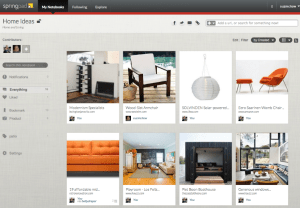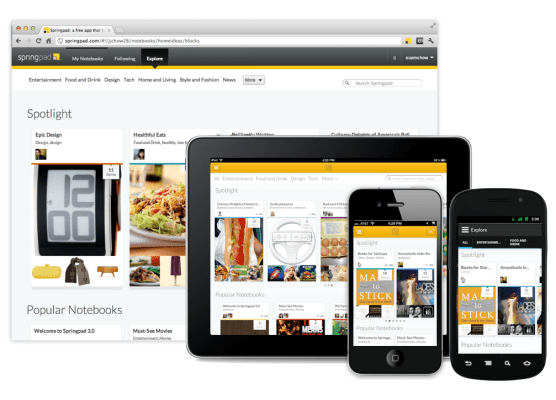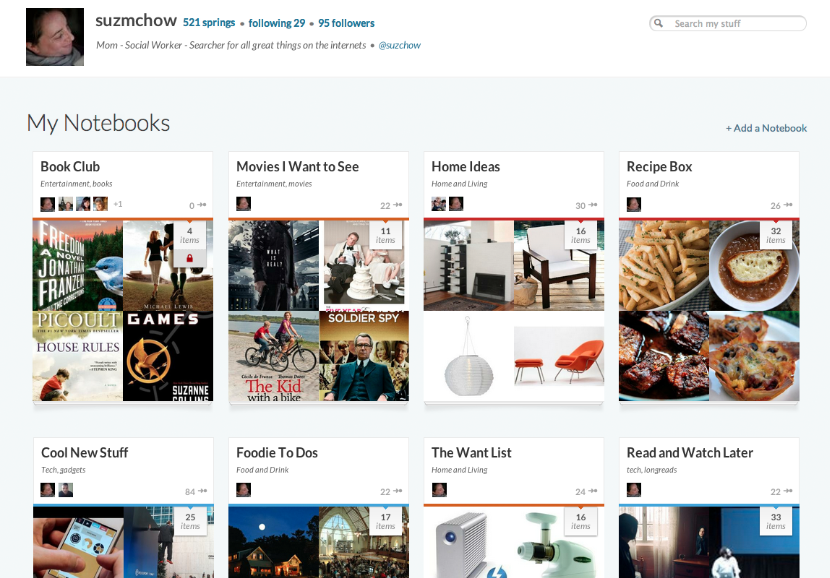Springpad was founded back in 2008 with a simple mission: Help people “remember stuff today so that they can make better decisions tomorrow.” For those unfamiliar with the digital organizer, the startup is the maker of free web, Android, and iOS productivity apps that constitute a multi-platform, cloud-based digital notebook, designed to help you discover, save, and share the things you care about. Springpad lets users jot notes, save websites, images, products, at which point its semantic data-parsing tech comes into play, analyzing your content and serving you alerts on relevant news, offers, price drops, and coupons.
Today, the startup is unveiling a completely redesigned Springpad 3.0, which boasts a new social experience that makes it easy for users to collaborate and share notebooks, discover ideas and information from trusted sources, i.e. your friends. The goal of the new app is to free users from the fleeting nature of social media streams by giving them anytime, anywhere access to their notebook’s content.
With the ever-growing noise and mess of content on the Web and on social networks, people are increasingly looking for better ways to curate their digital experiences and channel that white noise into signal. While the realtime web is unparalleled in serving news and enabling serendipitous discovery, Springpad wants to funnel the fire hose by giving users control over when and how they discover and filter information, including who they get that information from.
 With Springpad 3.0, users can now create and share notebook content in any form, be they recipes and books, or products and links. There’s also a new “Explore” section, which offers search functionality so that you can find and follow notebooks of interest from other community members.
With Springpad 3.0, users can now create and share notebook content in any form, be they recipes and books, or products and links. There’s also a new “Explore” section, which offers search functionality so that you can find and follow notebooks of interest from other community members.
The new version of Springpad adds much-needed, additional levels of sharing to let users make notebooks public, or keep them private, while offering the ability to co-curate and collaborate on notebooks with your friends. So, beyond being able to follow individual notebooks, Springpad 3.0 offers new filtering and organization options to let users tag, sort, change views, and find notebooks via category and tag pages.
The new version also adds to the apps’ alerts functionality, offering useful information like movie showtimes, as well as price comparison and reservation links, while alerts provide updates on price drops and offers on items you’ve saved in your notebook. And, of course, the startup’s apps offer online support on all devices, for all personal notebooks.
Lastly, Springpad has also added the ability to create personalized notebooks by choosing themes and accents, or take advantage of its new “Quick Add” bar, which offers bookmarklet and browser extensions to boost the apps’ search and saving experience.
In terms of social functionality, the startup’s platform upgrade today builds on the company’s announcement last year that it would begin offering users the ability to discover the likes, check-ins and recommendations from your Facebook friends so that you can view movies, TV shows, books, music, and places your friends recommend — even sorting that info based on friend and information type, by places, zip codes, and more.
 Springpad has long been considered a rival of the popular productivity app, Evernote, as both fundamentally seek to act as a memory aid for busy people, allowing users to capture anything and everything within apps or on the Web, and easily search content by keyword and tags. Yet, while Evernote has blown up in the past two years, soaring past 20 million users, Springpad has quietly been plugging along — adding features and building a viable competitor.
Springpad has long been considered a rival of the popular productivity app, Evernote, as both fundamentally seek to act as a memory aid for busy people, allowing users to capture anything and everything within apps or on the Web, and easily search content by keyword and tags. Yet, while Evernote has blown up in the past two years, soaring past 20 million users, Springpad has quietly been plugging along — adding features and building a viable competitor.
While the startup has traditionally stuck to its guns on being a memory aid, Springpad 3.0 is most importantly aimed at making its data more actionable. Storing and filtering information is certainly important in the face of the realtime web, but it’s all about how smart a platform can be in terms of learning one’s individual preferences, and serving them content based on those interests.
A hard thing to do, but Springpad is taking the right steps by enabling people to collaborate with families and friends on upcoming parties and projects, for example, or by allowing them to follow content from their favorite bands. Again, following is one thing, but serving users updates on discounted tickets, relevant tour info, and just offering an experience that makes it more likely for users to get off the couch and out to see live music — that’s where “it’s at,” as the kids say.
Sure, in terms of competing with Evernote, at 3 million users-plus, Springpad has a long way to go. But it’s features like its apps’ built-in barcode scanner that users can take advantage of to save info about products they come across in the real world that make Springpad an interesting alternative. Side-by-side, it’s also about beating the competition in terms of ease of use and simple, good-looking design. From what I’ve seen, Springpad has both.
What do you think? Is Springpad a viable competitor to Evernote in the long run — or more importantly, does it even need to be? With its new notebook sharing features and look, Springpad almost seems to follow into more direct competition with Pinterest …
For more on Springpad 3.0, check out the apps here.

